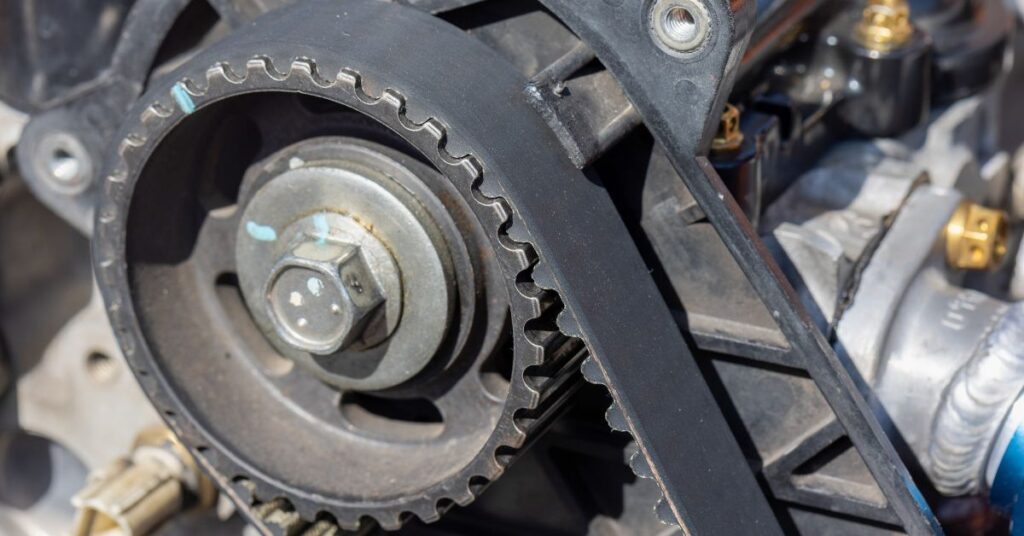
Table of Contents
What happens when a timing belt breaks? We wish the answer weren’t as serious as it is. When the timing belt in your vehicle snaps, it’s more than just an inconvenience. It can lead to a cascade of mechanical failures that could significantly impact the engine’s integrity. This article explains the aftermath of a timing belt failure, exploring the potential consequences on your engine and overall performance, and understanding what happens when a timing belt breaks is critical to appreciating the importance of regular maintenance and timely replacement to prevent costly repairs and ensure the longevity of your car.
What Is A Timing Belt?
The timing belt is a piece of precisely engineered equipment, typically made from high-grade rubber and reinforced with materials like fiberglass or Kevlar for strength and durability. This belt features a series of teeth on its inner surface designed to fit perfectly into the gears of the engine’s crankshaft and camshaft. These teeth ensure the belt moves in sync with these shafts, maintaining the critical timing for engine operation. This not-so-simple strip of reinforced rubber is engineered to synchronize the engine’s operations, linking the crankshaft and camshaft to maintain a precise timing of the engine’s valves and pistons.
Why Is Timing Important For An Engine?
The crankshaft is responsible for converting the linear motion of the pistons into rotational motion, and the camshaft is tasked with opening and closing the engine’s valves. These systems must operate in perfect harmony. That is where the timing belt comes in. The timing belt ensures these systems work in synch with one another, regulating the timing of the valve opening to let in air and fuel and then closing them for fuel combustion. This synchronization is crucial for a functioning engine. Even a slight misalignment can result in inefficient engine performance or severe damage.
What Happens When A Timing Belt Breaks?
When your timing belt breaks, the consequences can be severe and immediate. The timing belt’s role in synchronizing the engine’s valves and pistons is so crucial that its failure disrupts the entire engine operation, often with disastrous results.
Engine Stops Functioning: The most immediate effect of a timing belt break is that the engine will lose power and stop running. This can happen without warning, potentially leaving you stranded. Without the timing belt, the coordination between the crankshaft and camshaft is lost, leading to a complete halt in the engine’s operation.
Collision Between Pistons and Valves: The space within the cylinder is so tight that there is no room for error in the timing. If the valves are open when the piston moves upwards, the piston can collide with the valves. This collision can bend or break the valves, damage the pistons, and potentially harm the cylinder head and other engine components.
Costly Repairs: The aftermath of a timing belt failure can be financially burdensome. The damage from a broken belt can be extensive enough to require a complete engine rebuild or replacement.
Safety Risks: A timing belt failure while driving can pose serious safety risks. The sudden loss of power can lead to a breakdown in hazardous locations or situations, like busy highways or traffic, potentially leading to dangerous scenarios.
How To Know When To Replace Your Timing Belt?
Timely replacement of your timing belt is crucial to prevent the catastrophic effects of a break. However, unlike other car components that exhibit signs of distress, timing belts may not show signs of wear until it’s too late. Here’s how you can stay ahead:
Manufacturer’s Recommendations: The most reliable way to know when to replace your timing belt is to follow the manufacturer’s guidelines. Most manufacturers specify the interval for timing belt replacement in your vehicle’s manual, usually based on mileage. It’s often recommended to replace the timing belt every 60,000 to 100,000 miles, but this can vary depending on the make and model of your vehicle. If you’re unsure, the mechanics at our shop can inform you of your manufacturer’s recommendation.
Visual Inspection: While not always obvious, signs of wear, like cracks, fraying, or glazing on the belt or a change in its appearance, can indicate the need for a replacement. Our staff can inspect your timing belt during a routine service check.
Unusual Noises: Pay attention to any unusual sounds from the engine area. A high-pitched shriek, ticking, or whirring noise upon starting the engine or during acceleration could indicate that the timing belt is wearing out.
Engine Performance Issues: If you notice issues such as the engine misfiring, a loss in power, or your vehicle struggling to start, these could be indirect signs of a timing belt problem. While various issues can cause these symptoms, they should prompt a check of the timing belt.
Age of the Vehicle: Even if your vehicle hasn’t reached the mileage limit for timing belt replacement, consider the age of the belt. Rubber components degrade over time, so replacing the timing belt in older vehicles can preemptively avoid a break.
Other Related Repairs: If you’re having other related parts serviced, such as the water pump, which is often accessed via the same area as the timing belt, it might be cost-effective to replace it simultaneously, even if it hasn’t reached its mileage limit.
Contact McCullough NAPA Auto Care For Timing Belt Service
As we’ve explored in this article, a broken timing belt can lead to engine failure, extensive repairs, and even pose safety risks. Adhering to your vehicle’s maintenance schedule, paying attention to warning signs, and ensuring timely replacement is essential to safeguarding your vehicle’s performance and longevity.
If you’re unsure about the condition of your timing belt or if it’s time for a routine replacement, don’t wait for warning signs to become major problems. Contact McCullough NAPA Auto Care for assistance. Our team of ASE-certified technicians is equipped with the knowledge and tools to provide comprehensive timing belt service. We’ll ensure that your vehicle’s timing belt is in top condition, helping prevent any unexpected issues.
FAQ About When A Timing Belt Breaks
A broken timing belt can cause significant engine damage, especially in interference engines where the pistons and valves occupy the same space but at different times. The belt’s break can lead to collisions between pistons and valves, potentially resulting in costly repairs or even necessitating a complete engine replacement.
It is impossible to drive a car with a broken timing belt. The timing belt is crucial for the operation of the engine, and once it breaks, the engine will stop running and the car will not move. Attempting to drive with a broken belt can cause further damage.
Timing belts rarely give a warning before they break. Some signs may include a high-pitched noise from the engine or difficulty starting, but often the belt will fail without noticeable symptoms. Regular maintenance and replacement as per the manufacturer’s guidelines are the best prevention.
Whether it’s worth fixing a broken timing belt depends on the extent of the damage caused and the value of the vehicle. If the break has led to severe engine damage in an older car, the repair cost might outweigh the car’s value. In other cases, replacing the belt and repairing any damage can be a worthwhile investment.
Indications of a snapped timing belt include a sudden loss of power, the engine stopping abruptly, or failure to start. In some cases, you might hear a loud noise from the engine just before it shuts down. A mechanic can confirm a snapped belt through a visual inspection.
You cannot drive with a broken timing belt. Once the belt breaks, the engine will lose power immediately and the vehicle will come to a stop. Continuing to attempt to run the engine can result in additional damage. Immediate service is required in such situations.

